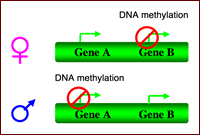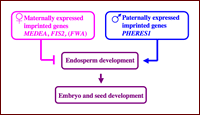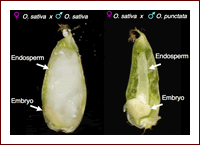Plant Reproductive Genetics Research Group
Group Member
 Assoc. Prof. Tetsu Kinoshita
Assoc. Prof. Tetsu Kinoshita

Fig. 1. Genomic imprinting

Fig. 2. Proposed role of imprinted genes in Arabidopsis

Fig. 3. Reproductive barrier observed in rice endosperm of inter-specific cross
Research and Education Outlined
During sexual reproduction, maternal and paternal chromosomes do not contribute equally to their offspring, even if they have identical nucleotide sequences, because the expression of certain genes is parent-of-origin-specific. This phenomenon, called genomic imprinting, is controlled by differential patterns of DNA methylation on the parental genes (Fig. 1). In plants, genomic imprinting controls endosperm development (Fig. 2) and is also related to the reproductive barrier observed in hybrid endosperm. We study these epigenetic mechanisms in Arabidopsis and rice.
Major research topics
- Mechanism of genomic imprinting in Arabidopsis
- Genomic imprinting is an epigenetic phenomenon resulting from unequal expression of maternally and paternally inherited alleles of a gene (Fig. 1). We have been studying the mechanism of genomic imprinting of FWA in Arabidopsis. Expression of FWA is controlled by methylation of tandem repeats in the 5 region of the gene. Activation of the maternal allele requires cytosine demethylation of thease repeats in the central cell within the female gametophyte. To further clarify how the silent state of FWA is converted to active state, we have screened and analyzed mutants that are defective in activation of a FWA-GFP reporter in the central cell.
- Reproductive barrier of inter-specific cross in rice
- Endosperm breakdown is a well-known phenomenon in inter-specific cross of many plant species, including rice (Fig. 3). Because overgrowth or undergrowth of the endosperm is determined by combination of the species, ploidy level and direction of the cross, genetic mechanisms are predicted to control this phenomenon. We are studying the mechanism of this reproductive barrier in rice endosperm, in relation to genomic imprinting.
References
- Ishikawa R. & Ohnishi T. et al., Plant Journal 65:798-806, 2011
- Ishikawa R. & Kinoshita T., Mol. Plant 2:589-599, 2009
- Ikeda Y. & Kinoshita T., Chromosoma, 118, 37-41, 2009
- Tiwari S. et al., Plant Cell, 20, 2387-2398, 2008
- Kinoshita T. et al., Seminars in Cell & Dev.Biol, 19, 574-579, 2008
- Fujimoto R. et al., PloS Genetics, 4, e1000048, 2008
- Kinoshita T., Genes & Genetic Systems, 82, 177-86, 2007
- Kinoshita Y. et al., Plant J., 49, 38-45, 2007
- Jullien PE. et al., Plant Cell, 18, 1360-1372, 2006
- Kinoshita T., et al., Science, 303, 521-523, 2004
